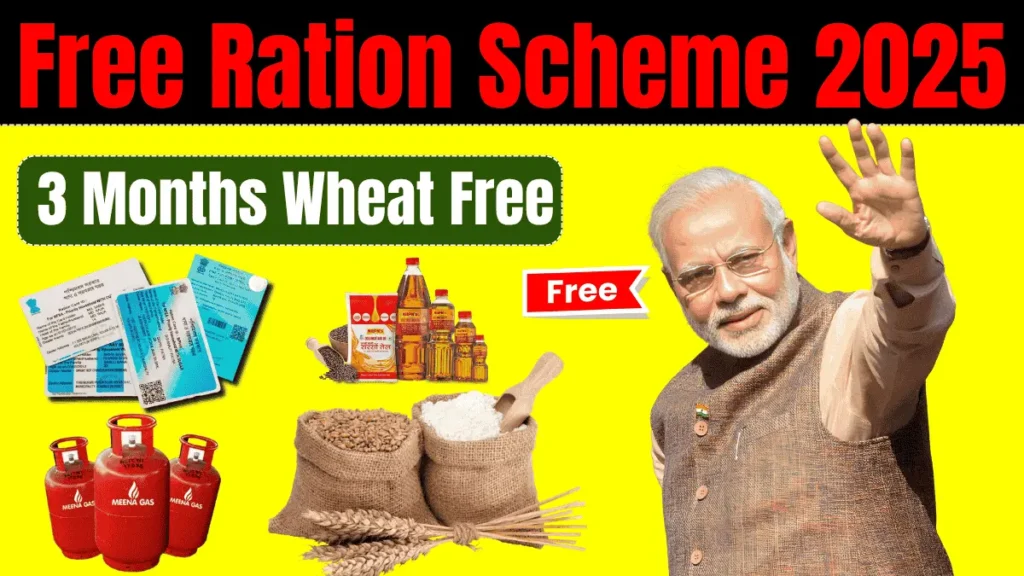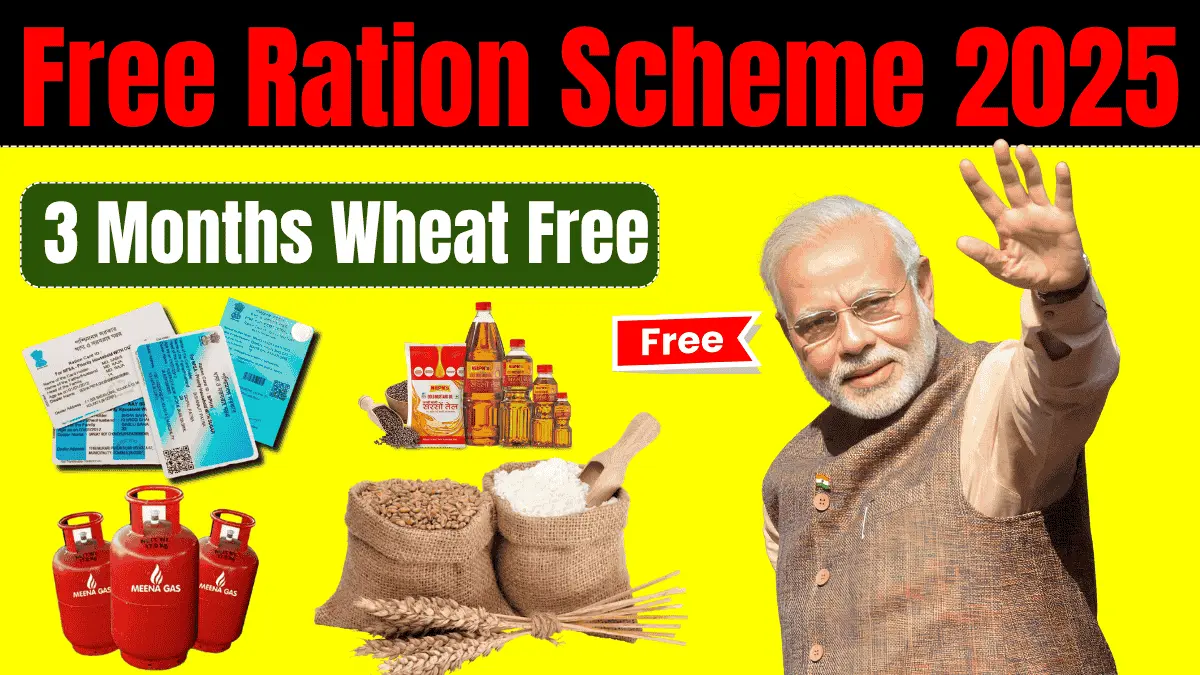In view of rising inflation and growing concerns about food security, the government is launching the Free Ration Scheme for 2025. The program aims to provide three months’ worth of essential staples wheat, rice, and pulses to eligible families at zero cost.
This initiative is a lifeline for households struggling to cope with rising prices and uncertain incomes. Below, the scheme’s features, eligibility criteria, application steps, and tips to ensure a smooth process are discussed in detail.

Purpose of the Scheme
The Free Ration Scheme 2025 has been introduced to strengthen social safety nets and ensure that vulnerable populations do not go hungry. The scheme recognizes that even basic staples have become unaffordable for many. By guaranteeing free access to wheat, rice, and pulses for three months, the government is stepping in to reduce food stress. The scheme is intended to improve nutrition, reduce malnutrition, and decrease the burden on low‑income families during difficult times. It also seeks to provide relief ahead of monsoon uncertainties, agricultural shocks, and global commodity price fluctuations.
What the Scheme Offers
Under the scheme, eligible families will receive three months’ supply of wheat, rice, and pulses. The quantity will be determined based on the number of family members and local dietary guidelines. For example, a family of four may receive a prescribed quantity of rice and wheat per month, along with a calculated share of pulses. All distributions will be free of cost. The scheme is intended to function via existing public distribution systems, fair price shops, or designated centers in villages and towns. Recipients will simply need to present their ration card or identification at the distribution point, and the commodities will be handed over.
Who Is Eligible
To benefit from the Free Ration Scheme 2025, families must satisfy certain eligibility criteria. The scheme targets low-income households, including those below the poverty line, families without stable employment, and households headed by daily wage earners. Women‑headed households, families with disabled or elderly members, and marginal farmers who are not otherwise supported by government welfare programs may also be prioritized. Applicants must not already receive free food benefits under another central scheme. They must possess a valid ration card or identity proof. Certain exclusions apply: families owning substantial land, having high vehicle ownership, or whose annual income exceeds a threshold determined by the government may be disqualified.
How to Apply
Applying for the Free Ration Scheme 2025 is designed to be as straightforward as possible to discourage bureaucratic delays. Applications may be submitted online through a designated government portal or via state food department websites. Offline options include submission at local fair price shop offices, ration supply offices, local revenue offices, or panchayat offices. Applicants must fill out a form providing details such as name, address, number of family members, income range, ration card number (if any), and identity proof (such as Aadhaar or voter ID). Once submitted, the application enters verification. After approval, the applicant receives a unique reference number and instructions on where and when to collect the free rations.
Verification and Approval
Verification of applications is important to prevent misuse and ensure that assistance reaches the needy. Local authorities will cross‑check applicant details against income records, property or land ownership records, and other government databases. In some cases, field verification or spot checks may be conducted. Once verified, a formal approval will be issued, and the family will be included in a beneficiary list. The list will be published at local government offices, fair price shops, or on state department websites to enable transparency and objections. Approved beneficiaries will receive an SMS, letter, or message indicating the collection point, dates, and quantities.
Distribution Mechanism
The distribution mechanism is built on the existing public distribution network to leverage infrastructure already in place. Designated fair price shops, food storage centers, or special distribution camps will act as collection points. Beneficiaries must carry valid identification and their ration card number or approval slip at the time of collection. The items will be issued at fixed times set by local authorities to maintain order. Officials will maintain logs of distributions, beneficiary signatures or thumb impressions, and balance stocks. States may also set up mobile distribution camps in remote areas to reach marginalized populations. Proper record keeping, audits, and oversight will be essential to ensure fairness and minimize pilferage.
Rights, Grievances and Appeals
Beneficiaries have rights under this scheme, including the right to transparent information about approved lists, distribution schedules, and stock levels. If a family’s name is excluded or their application rejected, they may file grievances or appeals. The scheme will set up grievance redressal mechanisms at the block or district level, with dedicated officials or ombudsmen handling complaints. Applicants may challenge rejections by presenting additional documents or requesting reconsideration. Periodic audits and citizen oversight committees may further ensure that grievance handling remains fair, timely, and accessible to all.
Timelines and Important Dates
The Free Ration Scheme 2025 will run in phases. In the first phase, applications will open soon after the government’s official announcement. The application window is likely to run for a few weeks, after which the verification process begins. Once verification is complete, distribution will be carried out over the next three months. The scheme may follow a staggered rollout across districts or states, depending on administrative capacity and resource availability. Beneficiaries will be informed of collection windows long in advance. The government may also set deadlines for submitting appeals or grievances. Eligible families should apply as early as possible to avoid missing the window.
Benefits to Families
The Free Ration Scheme 2025 carries significant benefits for struggling households. It relieves the immediate financial burden of buying basic food staples during times of crisis. The scheme helps ensure that children, elderly people, and pregnant women have access to essential nutrition. It reduces hunger stress and improves food security. With this support, families may redirect limited income toward healthcare, education, transport, or other necessities. In rural areas, it may reduce distress migration or cut the need to borrow money for food. For marginalized communities, this scheme represents a critical buffer against inflation and uncertainty.
Challenges and Risks
Implementing a massive scheme like this is not without challenges. One risk is leakage or corruption during distribution, which could deprive deserving families. Inaccurate or outdated beneficiary databases may lead to exclusion of eligible households or inclusion of ineligible ones. Logistical hurdles such as transport, storage, and infrastructure in remote areas pose challenges. Ensuring fair timing and crowd management at distribution points is another concern. Grievance systems may become overwhelmed with appeals or complaints. Finally, financial sustainability is crucial: the government must allocate sufficient funds and manage procurement, storage, and disbursal costs without straining resources.
How You Can Prepare
Families that believe they may be eligible should begin preparing documents now. Gather identity proofs, income certificates, land records, or property documents. Ensure that ration card information (if you have one) is up to date. Visit or inquire at local ration shops, food department offices, or panchayat offices about applying. Monitor announcements through state or district food supply departments. Be ready to submit applications as soon as the window opens. Take note of important dates and application deadlines. If possible, remain in contact with local officials or community groups so that you do not miss updates or changes in process.
Conclusion
The Free Ration Scheme 2025, providing three months’ worth of wheat, rice, and pulses to needy families, offers vital support in times of economic stress. By reducing the burden of food expenses, it helps families meet other essential costs and reinforces food security across vulnerable populations. While challenges remain in implementation, the scheme’s design builds upon existing infrastructure and seeks to ensure transparent, fair distribution. Eligible families should act promptly to apply, ensure documents are ready, and follow announcements carefully. In doing so, they can secure critical nutrition support for themselves and prevent hunger from worsening during trying times.
Disclaimer: This blog post is for informational purposes only. Eligibility, benefits, and procedures may vary by region. Always refer to official government sources for the most accurate and updated details.
